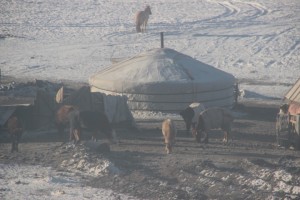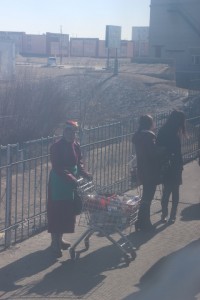Sunday 28th February
We reached Ulaanbaatar at around 7:00 a.m this morning. The temperature was -15C!! We awoke south of Ulaanbaatar as the railway made its way through mountains and eventually onto the Asian Steppe. This is a rough grassland just before a true desert.
The yurt (tent) is the traditional home of the Mongolian nomadic pastoralists. Many of these people live in permanent settlements now but old habits die hard.
We stopped for a while at Choir where there is a statue, at a distance, of the first Mongolian cosmonaut, VVT Ertvuntz. The local women meet the train to sell snacks and drinks.
The train continues south and enters the flat, arid and sparsely populated Gobi Desert. At first this is covered in deep snow and water courses are frozen, but further east and by the end of the day there is less snow and more traditional desert landscape. Access to water attracts animals and people but today in addition to cows, horses, camels, sheep and goats there are machines extracting minerals from the surface and beneath the desert.
Just a word about the Gobi Desert
This is the world’s most northern desert and is a barren plateau the size of Western Europe. It is 1000km north to south and 2400km west to east. It is more accurately described as a Cold Desert, definitely not to be confused with Polar Regions because they do not exhibit the conditions that means a place is a desert. All deserts experience average rainfall of 250mm, average temperatures of +30C and an average of 30% humidity. The Gobi experiences all this including temperatures of minus 30C in winter. Consequently it is a true desert. The Poles are not so! The Gobi is also landlocked and surrounded by mountains towards the middle of the continent of Asia so it does not receive moist, mild air from seas and oceans. From any direction the air passes over land so once the weather patterns and winds are established they take a long time to change. So this means that in winter the cold is intensified, likewise in summer the heat also.
The surface is covered with rounded gravel which appears to have been deposited by ice. There are sedimentary rocks which leads to Mongolia’s boom in mining and metamorphic rocks that produce copper, gold and other minerals. We also saw part of the encircling mountain range some of which are fold mountains produced by earth movements but some are clearly volcanic which lines of fumaroles extending over great distances. The black tephra (ash and pumice) covers the surface for large distances.
Before the Mongolian frontier it was time for dinner. The Russian restaurant had been changed to a Mongolian at the previous border. Unfortunately today’s speciality of liver and fat was not available!!
We continued until 8:45 p.m. reaching the Mongolian border town of Dzamyn-Ude where we waited for clearance for some 2 hours. Upon given clearance we moved across the Chinese border to Erlian where we were greeted by a light display and classical, popular and West End show music at the railway station. Here customs officials allowed us entry but progress to Beijing could not be made until we had the bogies (wheel carrying frames) changed from the Russian gauge of 5ft to the standard gauge of 4ft 8 1/2 inches. We stayed on board and were moved to a large shed where giant hydraulic lifts raised the carriages and men removed one bogie and replaced with the alternative. Past 1:00 a.m. we were on our way to Beijing.

















